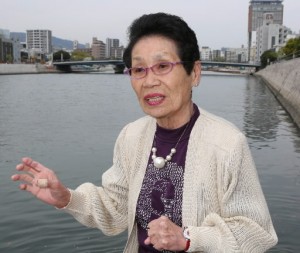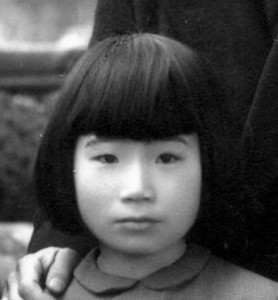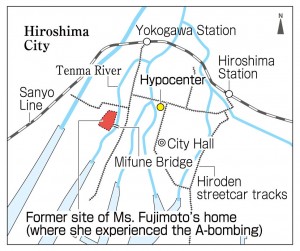Survivors’ Stories: Kiyoko Fujimoto, 75, Higashi Ward, Hiroshima
May 2, 2016
Felt no pain amid the horror of the city in flames
by Rie Nii, Staff Writer
When the atomic bombing took place, about one week had passed since Kiyoko Fujimoto (née Yamashita), 75, moved from Kitaeno-machi (now part of Naka Ward) to Higashikanon-machi (now part of Nishi Ward and about 1.1 kilometers from the hypocenter) with her mother and grandmother. When she finally arrived at the Tenma River and sought refuge in the water after running through the city in confusion, a female student abruptly grabbed her. Ms. Fujimoto’s mother desperately pulled her away from the student, saying, “Don’t take my daughter!” The scene is seared into Ms. Fujimoto’s memory.
At the time of the bombing, Ms. Fujimoto was four years and eight months old. She was playing house under the eaves of her home. After the sky grew dark for a moment, everything around her suddenly caught fire and the home was completely flattened. Her mother, Sasako, hurried to find her, calling her name, and Ms. Fujimoto clung to her mother tightly.
They moved to flee, but everything around them was on fire and they didn’t know which way to run. They saw a man trapped under a house that had collapsed. Only his head was sticking out and the flames consumed him as he cried out for help. Another man jumped into a fire cistern, where the water was boiling. “It’s hot!” he shrieked, dying there in the water.
A roof tile struck her mother’s head and made a bleeding wound, which she bound with a kimono underskirt that she happened to find. Ms. Fujimoto also suffered an injury, to her right leg, but she felt no pain amid the horror of the whole city in flames.
Ms. Fujimoto and her mother reached one end of Mifune Bridge, which spanned the Tenma River. Hugged by her mother, she went down the stone steps of the riverbank. With the tide ebbing, they saw black masses in the water. They were female students, charred by the bomb and floating in the river in heaps, crying out “Mother!” or “Long live the Emperor!” It was then that the student grabbed her.
After the tide went out, she and her mother collapsed to the sand of the riverbed. A woman then approached them, her eyeballs popped from their sockets and her burnt skin peeled and dangling from her arms and legs. Her skin, Ms. Fujimoto recalled, was sparkling with sand and she looked like a frightful apparition. “The ghosts are coming,” Ms. Fujimoto said to her mother. “We have to run away.”
After that, a soldier on horseback told Ms. Fujimoto and her mother to go to the Mitaki district (now part of Nishi Ward), a designated gathering place. Staggering, they reached the site, but then were told to go to the auditorium of a school in Furuichi-cho (now part of Asaminami Ward). She remembers how they finally arrived there and ate hard biscuits.
The next morning, her mother took her to the city center to search for her grandmother. They looked for a week to ten days, but were unable to find her. They finally came across some bones on a tangerine box that had been turned upside down on the site where their home had stood. “I think our house was here, so these remains must be your grandmother’s. We should pray for the repose of her soul,” her mother said and took the bones with them.
After the war, they spent their lives back and forth between the Minoura district (now part of the city of Kanonji) in Kagawa Prefecture, where Ms. Fujimoto’s mother had lived before she got married), and Gion-cho (now part of Asaminami Ward), where her grandmother’s distant relatives lived. When she turned five years old, her father, Tokuichiro, who had been dispatched to fight in Burma (today’s Myanmar) during the war, returned to Japan. But she found him frightening and it was hard for her to form a bond with him.
In 1960, her mother got the Atomic Bomb Survivor’s Certificate for her, but she faulted her mother for taking this step. Back then, known survivors of the bombing had difficulty finding marriage partners because it was said that they were unable to bear children. When she married Kazuma Fujimoto (who died in 1977 at the age of 43), she did not reveal that she was an A-bomb survivor.
She now has two daughters and three grandchildren and says, “I’m happiest now.” But even today, she feels that survivors are the object of prejudice when someone remarks that they are fortunate because the certificate enables them to receive free medical care. “When it came to experiencing the atomic bombing, I had no choice in the matter,” she says.
Ms. Fujimoto thinks that the human ego leads to war. She says that nothing is gained by war and hopes that everyone will seek peace and realize a world without ego.
Teenagers’ Impressions
Realizing a peaceful world without discrimination
Ms. Fujimoto hasn’t talked a lot about her experience of the atomic bombing because she feels discrimination. Facing discrimination is very hard, and if I were in her place, I couldn’t stand it. We should have accurate knowledge and shouldn’t accept a rumor as true without asking questions. I hope we can live in a peaceful world where no one experiences what Ms. Fujimoto had to face as a result of the atomic bombing. (Yukiho Saito, 14)
Experienced the horror of A-bombing at the age of four
Ms. Fujimoto detailed shocking scenes in the aftermath of the atomic bombing, including how fire spread to the man who was trapped under a house that had collapsed, only his head sticking out. Though she was only four years old, she remembers the bombing vividly. After the bombing took place, the city must have been a terrible sight. Nuclear weapons must be abolished so that scenes like this will never be repeated. (Aoi Nakagawa, 15)
The human ego leads to war
Ms. Fujimoto said, “I want you to create a world without ego because it’s human ego that leads to war.” I was surprised by these words because I had thought that hatred leads to war. I think the A-bomb survivors’ desire for peace is very persuasive. To begin with, I want to carry out a spirit of mutual respect with others. (Ishin Nakahara, 17)
(Originally published on May 2, 2016)
by Rie Nii, Staff Writer
When the atomic bombing took place, about one week had passed since Kiyoko Fujimoto (née Yamashita), 75, moved from Kitaeno-machi (now part of Naka Ward) to Higashikanon-machi (now part of Nishi Ward and about 1.1 kilometers from the hypocenter) with her mother and grandmother. When she finally arrived at the Tenma River and sought refuge in the water after running through the city in confusion, a female student abruptly grabbed her. Ms. Fujimoto’s mother desperately pulled her away from the student, saying, “Don’t take my daughter!” The scene is seared into Ms. Fujimoto’s memory.
At the time of the bombing, Ms. Fujimoto was four years and eight months old. She was playing house under the eaves of her home. After the sky grew dark for a moment, everything around her suddenly caught fire and the home was completely flattened. Her mother, Sasako, hurried to find her, calling her name, and Ms. Fujimoto clung to her mother tightly.
They moved to flee, but everything around them was on fire and they didn’t know which way to run. They saw a man trapped under a house that had collapsed. Only his head was sticking out and the flames consumed him as he cried out for help. Another man jumped into a fire cistern, where the water was boiling. “It’s hot!” he shrieked, dying there in the water.
A roof tile struck her mother’s head and made a bleeding wound, which she bound with a kimono underskirt that she happened to find. Ms. Fujimoto also suffered an injury, to her right leg, but she felt no pain amid the horror of the whole city in flames.
Ms. Fujimoto and her mother reached one end of Mifune Bridge, which spanned the Tenma River. Hugged by her mother, she went down the stone steps of the riverbank. With the tide ebbing, they saw black masses in the water. They were female students, charred by the bomb and floating in the river in heaps, crying out “Mother!” or “Long live the Emperor!” It was then that the student grabbed her.
After the tide went out, she and her mother collapsed to the sand of the riverbed. A woman then approached them, her eyeballs popped from their sockets and her burnt skin peeled and dangling from her arms and legs. Her skin, Ms. Fujimoto recalled, was sparkling with sand and she looked like a frightful apparition. “The ghosts are coming,” Ms. Fujimoto said to her mother. “We have to run away.”
After that, a soldier on horseback told Ms. Fujimoto and her mother to go to the Mitaki district (now part of Nishi Ward), a designated gathering place. Staggering, they reached the site, but then were told to go to the auditorium of a school in Furuichi-cho (now part of Asaminami Ward). She remembers how they finally arrived there and ate hard biscuits.
The next morning, her mother took her to the city center to search for her grandmother. They looked for a week to ten days, but were unable to find her. They finally came across some bones on a tangerine box that had been turned upside down on the site where their home had stood. “I think our house was here, so these remains must be your grandmother’s. We should pray for the repose of her soul,” her mother said and took the bones with them.
After the war, they spent their lives back and forth between the Minoura district (now part of the city of Kanonji) in Kagawa Prefecture, where Ms. Fujimoto’s mother had lived before she got married), and Gion-cho (now part of Asaminami Ward), where her grandmother’s distant relatives lived. When she turned five years old, her father, Tokuichiro, who had been dispatched to fight in Burma (today’s Myanmar) during the war, returned to Japan. But she found him frightening and it was hard for her to form a bond with him.
In 1960, her mother got the Atomic Bomb Survivor’s Certificate for her, but she faulted her mother for taking this step. Back then, known survivors of the bombing had difficulty finding marriage partners because it was said that they were unable to bear children. When she married Kazuma Fujimoto (who died in 1977 at the age of 43), she did not reveal that she was an A-bomb survivor.
She now has two daughters and three grandchildren and says, “I’m happiest now.” But even today, she feels that survivors are the object of prejudice when someone remarks that they are fortunate because the certificate enables them to receive free medical care. “When it came to experiencing the atomic bombing, I had no choice in the matter,” she says.
Ms. Fujimoto thinks that the human ego leads to war. She says that nothing is gained by war and hopes that everyone will seek peace and realize a world without ego.
Teenagers’ Impressions
Realizing a peaceful world without discrimination
Ms. Fujimoto hasn’t talked a lot about her experience of the atomic bombing because she feels discrimination. Facing discrimination is very hard, and if I were in her place, I couldn’t stand it. We should have accurate knowledge and shouldn’t accept a rumor as true without asking questions. I hope we can live in a peaceful world where no one experiences what Ms. Fujimoto had to face as a result of the atomic bombing. (Yukiho Saito, 14)
Experienced the horror of A-bombing at the age of four
Ms. Fujimoto detailed shocking scenes in the aftermath of the atomic bombing, including how fire spread to the man who was trapped under a house that had collapsed, only his head sticking out. Though she was only four years old, she remembers the bombing vividly. After the bombing took place, the city must have been a terrible sight. Nuclear weapons must be abolished so that scenes like this will never be repeated. (Aoi Nakagawa, 15)
The human ego leads to war
Ms. Fujimoto said, “I want you to create a world without ego because it’s human ego that leads to war.” I was surprised by these words because I had thought that hatred leads to war. I think the A-bomb survivors’ desire for peace is very persuasive. To begin with, I want to carry out a spirit of mutual respect with others. (Ishin Nakahara, 17)
(Originally published on May 2, 2016)










